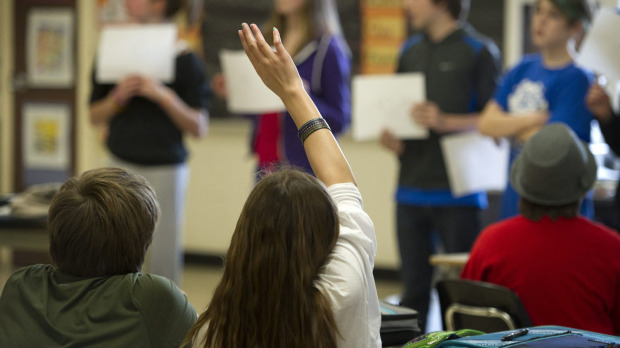class size to grow in Ontario?
 ..East Alternative School of TO Kevin Van Paassen:globe & Mail
..East Alternative School of TO Kevin Van Paassen:globe & Mail
For Ontario’s self-styled “education premier,” damning criticism of one of his signature changes to the province’s schools is nothing new.
Back when Dalton McGuinty took power in 2003, some of his own bureaucrats and advisers cautioned that lowering class sizes wouldn’t be worth the cost. In 2010, long after Mr. McGuinty’s Liberals had charged ahead anyway, Malcolm Gladwell used a keynote speech at their policy conference to call the investment a “ludicrous” waste of money. Now, previewing his government-commissioned report on public-service reform, economist Don Drummond has said there “isn’t really solid evidence” that it’s had value.
For all that, the Liberals continue to insist that it was the right policy. The argument they make, which is more about intangibles than hard evidence, is quite reasonable. But its backward-looking nature suggests that Mr. Drummond might have a point about the need to reconsider class sizes as the deficit-plagued government embarks on a sweeping cost-cutting exercise.
When Mr. McGuinty took office in 2003, they argue, the turmoil of the Mike Harris era had left a toxic atmosphere in schools. Teachers, feeling undervalued, were miserable. As a result, students were under-served. A growing number of parents were considering putting their kids into private schools.
The Liberals felt they needed a big gesture to restore faith in the system. And smaller class sizes, popular with teachers and easy for everyone else to grasp, fit the bill. So many hundreds of millions of dollars later, having hired thousands of additional teachers and renovated thousands of classrooms, the government now boasts that in the lowest grades about 90 per cent of classes have 20 students or fewer.
At the time of implementation, insiders recall, then-education minister Gerard Kennedy assured skeptics within the education sector that it would be worth investing in some goodwill, so the government would be able to get buy-in for less flashy reforms. And in that regard, the strategy seems to have borne results.
Schools are certainly happier places than they were back then. And that broader reform agenda, which among other things involves intervention by teachers to prevent struggling students from slipping through the cracks, has received international recognition for its role in better outcomes for students – including higher standardized test scores and a lower high-school drop-out rate.
But if smaller classes were really just about setting the right conditions, that leads to an obvious question: Is it time to declare mission accomplished, and move on a little?
No provincial government could have a better relationship with teachers than Mr. McGuinty’s. It’s been symbiotic; in return for generous workplace rules and wage increases, teachers have helped the Liberals meet both their policy and political goals, including helping during election campaigns. And understandably, the Liberals are less than eager to jeopardize that.
But if all that goodwill is real, then there should be some willingness to accept that the province’s current financial challenges – a $16-billion deficit and slow economic growth and potential credit-rating downgrades – require some sacrifice. And it should at least be possible to consider, if not a return to Harris-era class sizes, whether caps and targets could safely be raised a little from where they are now.
Of course, there’s another reason why Mr. Drummond’s advice about class sizes – like that of others before him – is likely to be rejected.
That argument about buying goodwill is only the one that’s been made in private. Publicly, the Liberals have been much less nuanced, holding up class sizes as the main cause of students’ improved results. It wasn’t just presented as a means to an end; it was their signature education policy, helping them get elected and re-elected.
Having gone down that route, it would be very difficult politically to concede that it might not be quite so essential a policy after all. In retrospect, had the Liberals known the financial crunch to come, perhaps they would’ve been less eager to stake their reputations to a largely symbolic gesture.
From Monday’s Globe and Mail Last updated Monday, Jan. 09, 2012 1:39AM EST
Time for McGuinty to reconsider class sizes?
ADAM RADWANSKI | Columnist profile | E-mail



